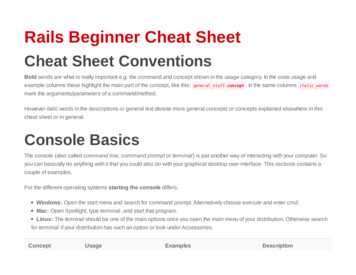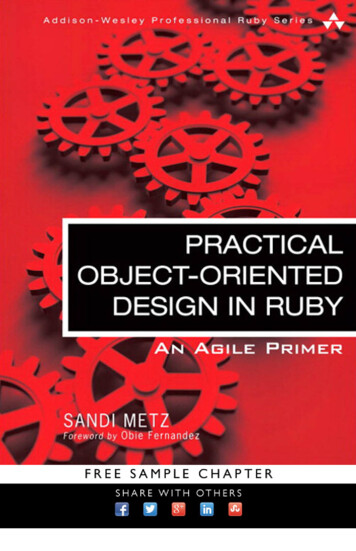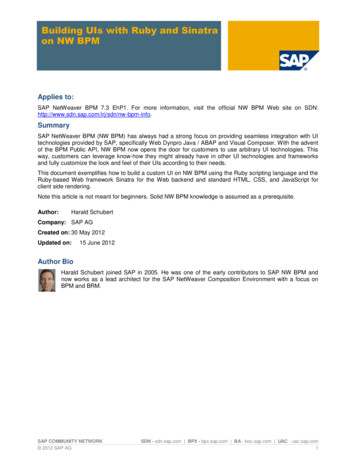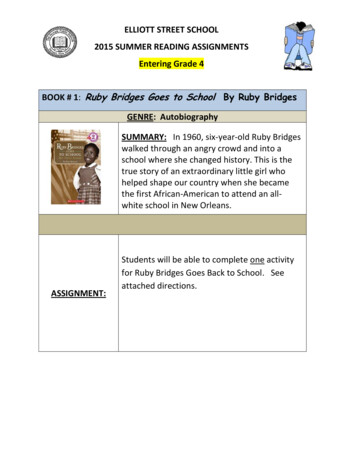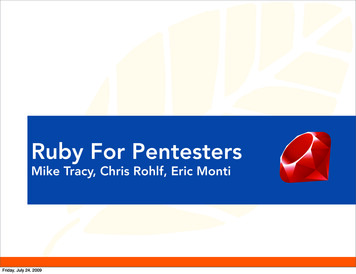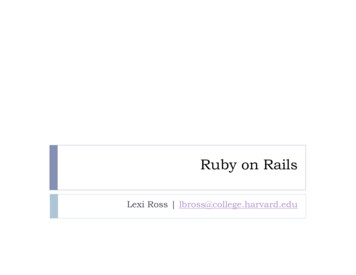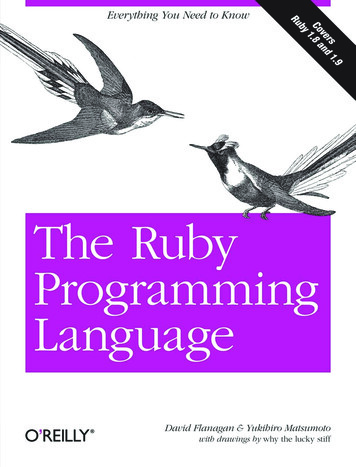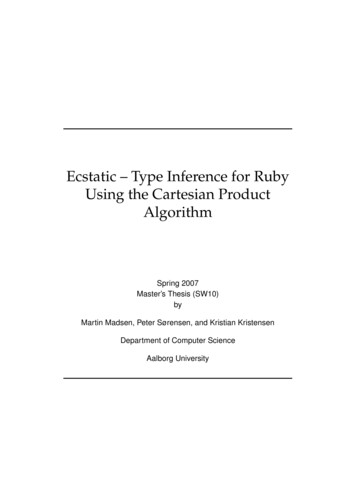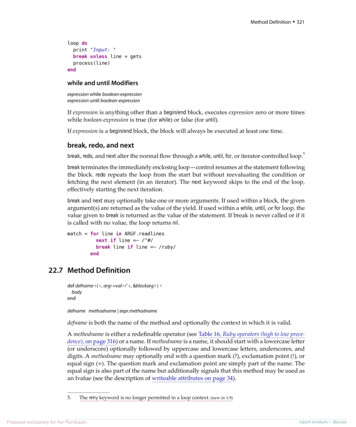
Transcription
Method Definition 321loop doprint "Input: "break unless line getsprocess(line)endwhile and until Modifiersexpression while boolean-expressionexpression until boolean-expressionIf expression is anything other than a begin/end block, executes expression zero or more timeswhile boolean- ‐‑expression is true (for while) or false (for until).If expression is a begin/end block, the block will always be executed at least one time.break, redo, and next5break, redo, and next alter the normal flow through a while, until, for, or iterator- ‐‑controlled loop.break terminates the immediately enclosing loop—control resumes at the statement followingthe block. redo repeats the loop from the start but without reevaluating the condition orfetching the next element (in an iterator). The next keyword skips to the end of the loop,effectively starting the next iteration.break and next may optionally take one or more arguments. If used within a block, the givenargument(s) are returned as the value of the yield. If used within a while, until, or for loop, thevalue given to break is returned as the value of the statement. If break is never called or if itis called with no value, the loop returns nil.match for line in ARGF.readlinesnext if line / #/break line if line /ruby/end22.7 Method Definitiondef defname ‹ ( ‹ , arg‹ val › ›* ‹ , &blockarg › )bodyend›defname methodname expr.methodnamedefname is both the name of the method and optionally the context in which it is valid.A methodname is either a redefinable operator (see Table 16, Ruby operators (high to low prece- ‐‑dence), on page 316) or a name. If methodname is a name, it should start with a lowercase letter(or underscore) optionally followed by uppercase and lowercase letters, underscores, anddigits. A methodname may optionally end with a question mark (?), exclamation point (!), orequal sign ( ). The question mark and exclamation point are simply part of the name. Theequal sign is also part of the name but additionally signals that this method may be used asan lvalue (see the description of writeable attributes on page 34).5.The retry keyword is no longer permitted in a loop context. (new in 1.9)Prepared exclusively for Avi Flombaumreport erratum discuss
Chapter 22. The Ruby Language 322A method definition using an unadorned method name within a class or module definitioncreates an instance method. An instance method may be invoked only by sending its nameto a receiver that is an instance of the class that defined it (or one of that class’s subclasses).Outside a class or module definition, a definition with an unadorned method name is addedas a private method to class Object. It may be called in any context without an explicitreceiver.A definition using a method name of the form expr.methodname creates a method associatedwith the object that is the value of the expression; the method will be callable only by sup- ‐‑plying the object referenced by the expression as a receiver. This style of definition createsper- ‐‑object or singleton methods. You’ll find it most often inside class or module definitions,where the expr is either self or the name of the class/module. This effectively creates a classor module method (as opposed to an instance method).class MyClassdef MyClass.methodendend# definitionMyClass.method# callobj Object.newdef obj.methodend# definitionobj.method# calldef (1.class).fredend# receiver may be an expressionFixnum.fred# callMethod definitions may not contain class or module definitions. They may contain nestedinstance or singleton method definitions. The internal method is defined when the enclosingmethod is executed. The internal method does not act as a closure in the context of thenested method—it is self- ‐‑contained.def toggledef toggle"subsequent times"end"first time"endtoggletoggletoggle# "first time"# "subsequent times"# "subsequent times"The body of a method acts as if it were a begin/end block, in that it may contain exception- ‐‑handling statements (rescue, else, and ensure).Prepared exclusively for Avi Flombaumreport erratum discuss
Method Definition 323Method ArgumentsA method definition may have zero or more regular arguments and an optional blockargument. Arguments are separated by commas, and the argument list may be enclosed inparentheses.A regular argument is a local variable name, optionally followed by an equals sign and anexpression giving a default value. The expression is evaluated at the time the method iscalled. The expressions are evaluated from left to right. An expression may reference aparameter that precedes it in the argument list.def options(a 99, b a 1)[ a, b ]endoptions# [99, 100]options(1)# [1, 2]options(2, 4) # [2, 4]In Ruby 1.9, arguments without default values may appear after arguments with defaults.When such a method is called, Ruby will use the default values only if fewer parameters arepassed to the method call than the total number of arguments.def mixed(a, b 50, c b 10,[ a, b, c, d ]endmixed(1, 2)# [1,mixed(1, 2, 3)# [1,mixed(1, 2, 3, 4) # [1,New in 1.9d)50, 60, 2]2, 12, 3]2, 3, 4]As with parallel assignment, one of the arguments may start with an asterisk. If the methodcall specifies any parameters in excess of the regular argument count, all these extraparameters will be collected into this newly created array.def varargs(a, *b)[ a, b ]endvarargs(1)# [1, []]varargs(1, 2)# [1, [2]]varargs(1, 2, 3) # [1, [2, 3]]In Ruby 1.9, this argument need not be the last in the argument list. See the description ofparallel assignment to see how values are assigned to this parameter.New in 1.9def splat(a, *b, c)[ a, b, c ]endsplat(1, 2)# [1, [], 2]splat(1, 2, 3)# [1, [2], 3]splat(1, 2, 3, 4) # [1, [2, 3], 4]If an array argument follows arguments with default values, parameters will first be usedto override the defaults. The remainder will then be used to populate the array.def mixed(a, b 99, *c)[ a, b, c]endPrepared exclusively for Avi Flombaumreport erratum discuss
Chapter 22. The Ruby Languagemixed(1)mixed(1, 2)mixed(1, 2, 3)mixed(1, 2, 3, 4)#### [1,[1,[1,[1, 32499, []]2, []]2, [3]]2, [3, 4]]The optional block argument must be the last in the list. Whenever the method is called,Ruby checks for an associated block. If a block is present, it is converted to an object of classProc and assigned to the block argument. If no block is present, the argument is set to nil.def example(&block)puts block.inspectendexampleexample { "a block" }produces:nil# Proc:0x007ff37b905468@/tmp/prog.rb:6 Undefining a MethodThe keyword undef allows you to undefine a method.undef name symbol .An undefined method still exists; it is simply marked as being undefined. If you undefinea method in a child class and then call that method on an instance of that child class, Rubywill immediately raise a NoMethodError—it will not look for the method in the child’s parents.22.8 Invoking a Method‹ receiver. ›name‹ parameters › ‹ {block} ›‹ receiver:: ›name‹ parameters › ‹ {block} ›parameters ( ‹ param ›* ‹ , hashlist › ‹ *array › ‹ &a proc › )block { blockbody } or do blockbody endThe parentheses around the parameters may be omitted if it is otherwise unambiguous.New in 1.9New in 1.9Initial parameters are assigned to the actual arguments of the method. Following theseparameters may be a list of key value or key: value pairs. These pairs are collected into asingle new Hash object and passed as a single parameter.Any parameter may be a prefixed with an asterisk. If a starred parameter supports the to amethod, that method is called, and the resulting array is expanded inline to provideparameters to the method call. If a starred argument does not support to a, it is simply passedthrough unaltered.def regular(a, b, *c)"a #{a}, b #{b}, c #{c}"endregular 1, 2, 3, 4regular(1, 2, 3, 4)regular(1, *[2, 3, 4])Prepared exclusively for Avi Flombaum# a 1, b 2, c [3, 4]# a 1, b 2, c [3, 4]# a 1, b 2, c [3, 4]report erratum discuss
Invoking a Methodregular(1, *[2, 3], 4)regular(1, *[2, 3], *4)regular(*[], 1, *[], *[2, 3], *[], 4) 325# a 1, b 2, c [3, 4]# a 1, b 2, c [3, 4]# a 1, b 2, c [3, 4]A block may be associated with a method call using either a literal block (which must starton the same source line as the last line of the method call) or a parameter containing a refer- ‐‑ence to a Proc or Method object prefixed with an ampersand character.def some methodyieldendsome method { }some method doenda proc lambda { 99 }some method(&a proc)Ruby arranges for the value of Object#block given? to reflect the availability of a block associ- ‐‑ated with the call, regardless of the presence of a block argument. A block argument will beset to nil if no block is specified on the call to a method.def other method(&block)puts "block given #{block given?}, block #{block.inspect}"endother method { }other methodproduces:block given true, block # Proc:0x007fe6a9885b70@/tmp/prog.rb:4 block given false, block nilA method is called by passing its name to a receiver. If no receiver is specified, self is assumed.The receiver checks for the method definition in its own class and then sequentially in itsancestor classes. The instance methods of included modules act as if they were in anonymoussuperclasses of the class that includes them. If the method is not found, Ruby invokes themethod method missing in the receiver. The default behavior defined in Object#method missingis to report an error and terminate the program.When a receiver is explicitly specified in a method invocation, it may be separated from themethod name using either a period (.) or two colons (::). The only difference between thesetwo forms occurs if the method name starts with an uppercase letter. In this case, Ruby willassume that receiver::Thing is actually an attempt to access a constant called Thing in thereceiver unless the method invocation has a parameter list between parentheses. Using :: toindicate a method call is mildly ethod callmethod callmethod callconstant accessThe return value of a method is the value of the last expression executed. The method in thefollowing example returns the value of the if statement it contains, and that if statementreturns the value of one of its branches.Prepared exclusively for Avi Flombaumreport erratum discuss
Chapter 22. The Ruby Language 326def odd or even(val)if val.odd?"odd"else"even"endendodd or even(26) # "even"odd or even(27) # "odd"A return expression immediately exits a method.return ‹ expr ›*The value of a return is nil if it is called with no parameters, the value of its parameter if it iscalled with one parameter, or an array containing all of its parameters if it is called withmore than one parameter.supersuper ‹ ( ‹ , param ›* ‹ , *array › )› ‹ block ›Within the body of a method, a call to super acts like a call to the original method, except thatthe search for a method body starts in the superclass of the object that contained the originalmethod. If no parameters (and no parentheses) are passed to super, the original method’sparameters will be passed; otherwise, the parameters to super will be passed.Operator Methodsexpr operatoroperator exprexpr1 operator expr2If the operator in an operator expression corresponds to a redefinable method (see Table 16,Ruby operators (high to low precedence), on page 316), Ruby will execute the operator expressionas if it had been written like this:(expr1).operator() or(expr1).operator(expr2)Attribute Assignmentreceiver.attrname rvalueWhen the form receiver.attrname appears as an lvalue, Ruby invokes a method named attrname in the receiver, passing rvalue as a single parameter. The value returned by this assignmentis always rvalue—the return value of the method is discarded. If you want to access the returnvalue (in the unlikely event that it isn’t the rvalue), send an explicit message to the method.class Demoattr reader :attrdef attr (val)@attr val"return value"endendPrepared exclusively for Avi Flombaumreport erratum discuss
Aliasing 327d Demo.new# In all these cases, @attr is set to 99d.attr 99# 99d.attr (99)# 99d.send(:attr , 99) # "return value"d.attr# 99Element Reference Operatorreceiver[ ‹ expr › ]receiver[ ‹ expr › ] rvalueWhen used as an rvalue, element reference invokes the method [] in the receiver, passing asparameters the expressions between the brackets.When used as an lvalue, element reference invokes the method [] in the receiver, passingas parameters the expressions between the brackets, followed by the rvalue being assigned.22.9 Aliasingalias new name old nameThis creates a new name that refers to an existing method, operator, global variable, or reg- ‐‑ular expression backreference ( &, , ', and ). Local variables, instance variables, classvariables, and constants may not be aliased. The parameters to alias may be names or symbols.class Fixnumalias plus end1.plus(3)# 4alias prematch "string" /i/ # 3 prematch# "str"alias :cmd : cmd "date"# "Sat Jul 14 23:48:34 CDT 2012\n"When a method is aliased, the new name refers to a copy of the original method’s body. Ifthe method is subsequently redefined, the aliased name will still invoke the original imple- ‐‑mentation.def meth"original method"endalias original methdef meth"new and improved"endmeth# "new and improved"original # "original method"Prepared exclusively for Avi Flombaumreport erratum discuss
defodd_or_even(val) ifval.odd? "odd" else "even" end end odd_or_even(26) # "even" odd_or_even(27) # "odd" Areturnexpressionimmediatelyexitsamethod. return .
